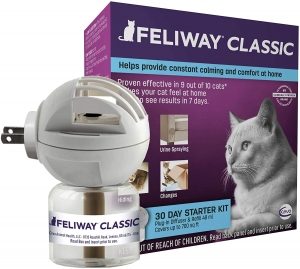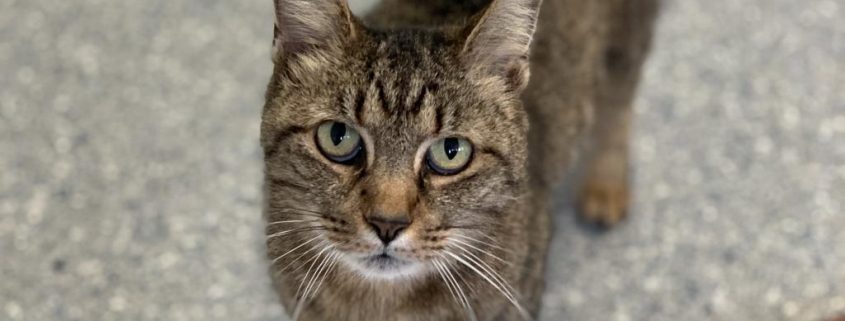Ask Crystal: Half Trained Cat
Welcome to “Ask Crystal,” where you can ask your pet behavior questions! You can submit your question for Crystal at the bottom of the page!

Dear Crystal,
My male cat refuses to use his litter box to poop. He will only pee in there. What can we do to convince him it’s okay?
Sincerely,
Frustrated Cat Parent
Dear Frustrated,
Cat litter box problems are one of the more frustrating issues cat parents face. Why should our feline friends suddenly decide to eschew their litter pans? At least 10% of cats develop elimination problems in their lifetime so it is something a lot of people have to deal with at some point. There are a variety of reasons why a cat might develop this issue.
If this behavior is new, any time an animal suddenly has a change in behavior, the first thing to do is make an appointment with your pet’s veterinarian. It is best to rule out a medical condition right away. There are a number of medical conditions that can cause litter box problems. We can make all the changes in the world and it is not going to make any difference if there is an ongoing medical issue. If your vet gives your cat a clean bill of health it may have a behavioral issue.
Cats have a reputation for being particular and it is certainly true of some cats in terms of the litter boxes. Cats can have a preference for the type of litter, cleanliness, locations of litter boxes amongst other things.
A lot of cats don’t like scented litter. A good alternative is a layer of baking soda on the bottom of the litter pan rather than perfumed litter. They may have a preference for the size of litter. Some cats prefer the fine grains of clumping litter for the feel on their paws. Declawed kitties prefer soft non-clumping litter. It may also be a preference for the type of litter that they had as a kitten. You may want to consider adding an additive called Cat Attract to your cat’s litter or using the brand’s cat litter. It claims to help encourage cats to use the litter box. The depth of the litter should be no more than 2 inches for most cats and some cats are fine with a half an inch of litter.
 Cats can be very particular about the cleanliness of the litter as well. Be sure to scoop feces daily. How much you change the litter will depend on the type of litter, how many boxes you have and how many cats. Wash boxes out weekly with unscented soap.
Cats can be very particular about the cleanliness of the litter as well. Be sure to scoop feces daily. How much you change the litter will depend on the type of litter, how many boxes you have and how many cats. Wash boxes out weekly with unscented soap.
The location of the box is also important. Keep it away from food and water bowls. Avoid placing near noisy appliances like dryers or furnaces. If you live in a multistory home, provide a box on every level. Provide at least one box per cat plus one. Put boxes in places that are quiet and private but easy to get to and have multiple escape routes. Cats don’t like boxes in heavy traffic areas as they may not feel safe.
The cat may have a preference for a type of litter box as well. The litter box should be larger than many commercial boxes are. A good alternative is an under the bed tote box, it’s a perfect size for most cats. Some cats don’t like covered or hooded boxes.
Sometimes the original reason for the problem is not the reason why it is continuing. For example, the cat started going outside the box because of a medical problem which is now resolved but now he prefers to go on the floor.
If the cat has developed a preference for eliminating on another surface or location, you can try to make that area less appealing. Add bright lights or motion sensors that go off if the cat goes into the area. You can try placing tin foil or double-sided tape to an area. If the cat has been going in a particular area, you can also try placing a litter box in that area. Cats don’t like citrus scents so you could place citrus scent items in the area you don’t want him going in. Clean all previous accidents with an enzymatic cleaner like Nature’s Miracle.
If they prefer soft surfaces, you can try shredded newspaper, pine shavings, or a piece of carpet that gets changed out in the litter pan. You can start sprinkling litter over it to convert him to litter. If he likes bare surfaces, try an empty box or a box with very little litter. If the cat has been an outside cat and prefers dirt, you could mix some dirt in the litter to transition him or just use dirt. Some cats that don’t like any cat litter brands, will use playground sand.
Besides the actual litter box and medical issues, there are other causes for elimination problems. If something in the environment or routine has changed such as a recent move or a new addition to the family, that can cause problems. It can also be related to conflicts with other cats or animals in the family.
 Try reducing his stress levels. Cats don’t deal well with change and stress can cause this behavior. Play calming music when you are gone. Give him a couple play sessions with a feather wand before meals. Provide meals in a food puzzle toy to provide mental stimulation. You can also try a Feliway diffuser or spray to provide soothing pheromones.
Try reducing his stress levels. Cats don’t deal well with change and stress can cause this behavior. Play calming music when you are gone. Give him a couple play sessions with a feather wand before meals. Provide meals in a food puzzle toy to provide mental stimulation. You can also try a Feliway diffuser or spray to provide soothing pheromones.
He could have a negative association with the box. One of the things that can happen with a medical issue is that the cat can develop a negative association with the litter box if they felt pain or discomfort even once while in the box. Let’s say for example, your cat had constipation and was feeling pain and discomfort while trying to go potty in the box. He then could think it was being in the box that caused the pain. Or if he was startled, scared or ambushed by someone while in the box. The cat that is afraid of the box may go in and quickly run out of the box. He may also have accidents near the box.
It is not a good idea to try to put the cat in the box as that may be negative or scary for them. We can’t really use treats like we would with a dog as most cats do not want to eat while eliminating. The easiest solution for the cat with a negative association to the box is to offer new boxes in new areas with a new type of litter. It should have multiple escape routes and be sure children and dogs that might scare it, stay away from these areas. You could try playing with the cat near the box or leaving treats in the area for her to find.
If all these tips do not help, find a certified cat behavior consultant here. They can help you identify the cause and change the cat’s behavior. I hope you can identify the cause of your cat’s behavior and develop a plan for helping him feel more comfortable in his litter box. Good luck!
Until next time,
Crystal







